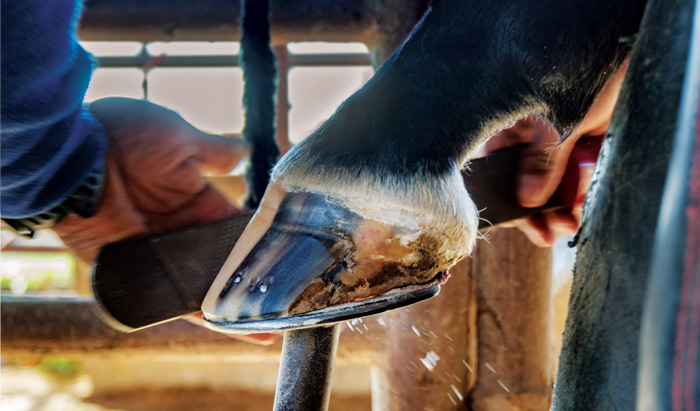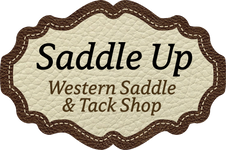To Shoe or Not to Shoe
Posted by Lynnsy Johnson - Saddle Up on Jan 30th 2020
One of the biggest debates within the horse community is whether to shoe your horse or keep them barefoot. There are pro's and con's to both options, but it all comes to down to what is best for your horse. Each individual horse has its own needs. You have to evaluate yours and see what they would benefit from most. There are a few key factors that can help you decided which we will go over today.
Hooves grow constantly, just like human fingernails. Domesticated horses do not wear their feet down like wild horses, so they need a farrier to routinely trim their hooves, or shoe if necessary. The hoof is made to bear the horse's full weight and provide comfortable movement. Healthy hooves are key to avoid lameness, discomfort, and further injuries/health problems. If their hooves aren't healthy, it can also affect their usefulness. There's a saying out there that goes, " No hoof, no horse."
Horses who are barefoot over a long period build up their own natural protection and usually a horse doesn't necessarily need shoes. There are a few things to think about when pondering the idea of shoes. Is this horse a performance horse? What kind of terrain does this horse endure? Does this horse have previous medical conditions, conformation issues, or injuries? Does this horse have poor hoof health currently? Evaluating your horse based on this information, will help you decide if you need to shoe or not.
The biggest downfall to shoeing in my opinion is the cost. It is more expensive to shoe a horse than do a regular trim. It can get pricey if you have more than horse needing shoes or if they need special/corrective shoeing. Their are also some risks to be aware of if you choose to shoe. A big risk is a farrier hot nailing (misplacing the nail) and it can cause issues such as discomfort and even abscesses. I can not stress this enough, do your research on farriers before selecting one. It is so important to find a farrier who is experienced and professional. If they do not know what they are doing, they can cause a lot of damage to your horse. Be sure to use a credible farrier, even if they cost more. It is worth the extra money to have a job done right than potentially ruining your horse. Another thing to be aware of is if your horse pulls a shoe off, it can cause damage.
If your horse has a conformation issue, they may need the additionally support of a shoe. An example would be if you have a horse who has crooked legs, corrective shoeing will work on straightening the legs and preventing lameness. If you suspect your horse has conformation issues, talk to your vet and farrier to see if corrective shoeing is the right solution.
Another key factor is what is the ground like where your horse lives or where you ride? If it is rocky or hard ground, shoes may be good idea. A lot of trail riders shoe their horses because of the different terrain they ride in. If the ground is hard and rocky, it can cause a bare hoof soreness or even bruising. The shoes can provide protection and traction for more difficult ground.
If your horse has had previous injuries or medical conditions, they may need shoes to be more comfortable and have added support. For example, if your horse has an old fracture or an injured tendon, sometimes shoes may help keep them sound and more comfortable. Another common medical condition is a horse being navicular. In this case, they do require special shoeing. If a horse's feet have been neglected for a long period of time, they may have thinner soles or other issues that may require them to have shoes. X-rays are a good indicator to see what is going on inside the hoof. It can give you more insight as to what your horse needs to make them more comfortable. It is so important to keep up on your horse's hooves and get them on a 6-8 week schedule.
A big thing to consider too is what are you using this horse for? If this is a performance horse, shoes can be helpful to provide more protection and more traction. For example, barrel racers tend to shoe their horses so they get good traction and have less of a chance to slip going around the barrels. When competing, you also never know the condition of the ground, so shoes can provide protection just in case. Shoes can optimize performance in many ways. It is very common for rodeo competitors to shoe in the summer during the busy season and then go barefoot in the winter during their off season.
All in all, it is what works best for your particular horse. Leaving your horse barefoot is more natural and less expensive, but some horses just need shoes. Think of it as people and glasses. Some people have excellent vision and therefore don't need glasses. Other people struggle with vision and so they need glasses or contacts to help them. Evaluate your horse and it's background. If your horse does not meet any of the criteria for shoes, then they don't need shoes. At that point it is totally your choice to shoe or to keep them barefoot.
Chatting with your vet and farrier can also help you decide which option is better for you. Remember hoof health is very important and so is finding the right farrier for you and your horse. If you need recommendations please feel free to reach out to us and we can suggest a few farriers. Thank you so much and have a great rest of your week!

(picture credit: https://www.americanfarriers.com/articles/9708-simple-and-straightforward-shoeing-helps-young-horse-recover?v=preview)
